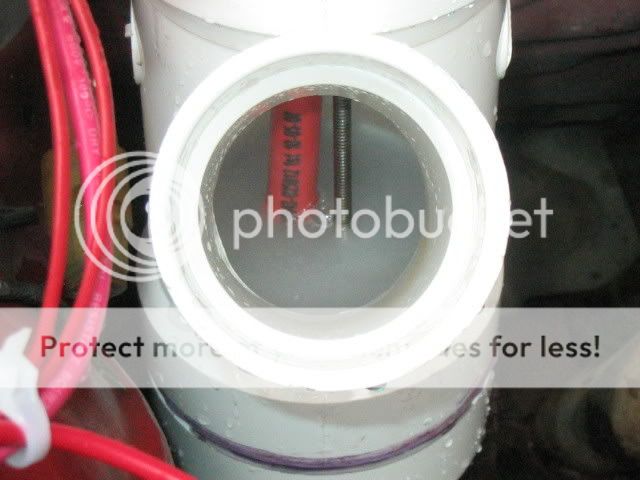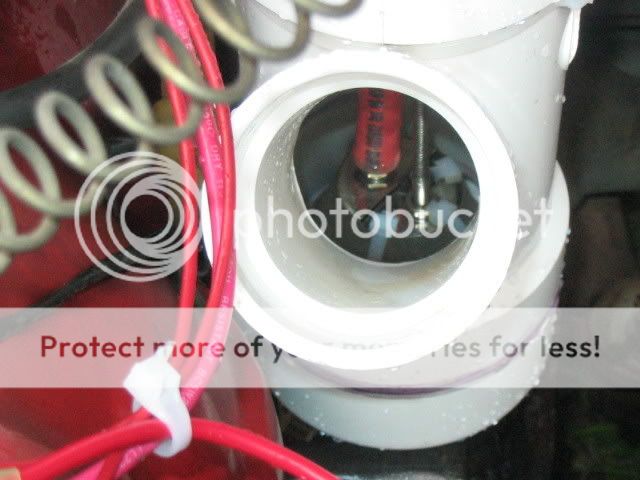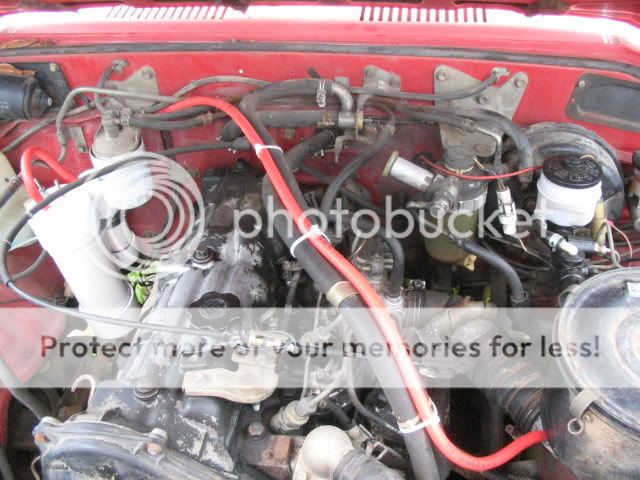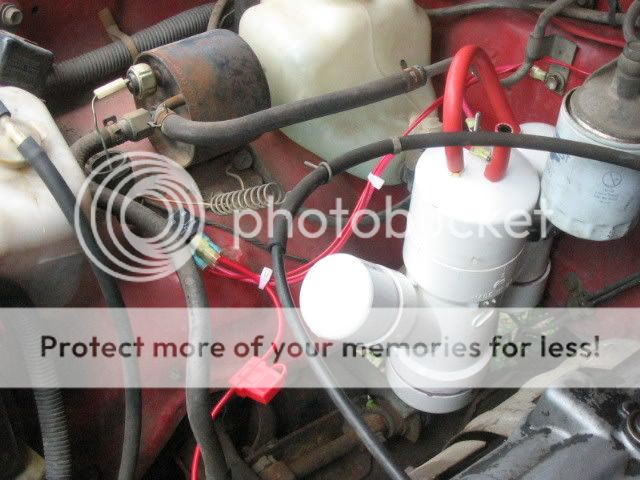It looks like you're using an Ad Blocker.
Please white-list or disable AboveTopSecret.com in your ad-blocking tool.
Thank you.
Some features of ATS will be disabled while you continue to use an ad-blocker.
share:
What do you all know about Brown's gas? (HHO)?
I've have heard about it in the past but didn't think anything about it but lately I've heard some stories about how you can run your car on it and stuff like that. After doing a little digging I have to say I am I am intrigued due to some properties I was not aware of.
The only link I will post on it for now is this one:
Let's start with a known fact:
Water through electrolysis can be broken down:
Notice that after the water and oxygen separates, they are in 'diatomic' states. (Always paired.. H2 or O2)
Now, according to what I have been reading Hydrogen and Oxygen can exist separately in a 'monatomic' state.. Ie.. O and H by themselves.
Brown's gas or HHO is water that's been decomposed but it's components kept in a MONATOMIC state somehow. (Apparently by keeping it in the same container and under some mysterious amount of pressure and while in this state possesses some amazing properties)
This is where it starts to get away from me and where I would like some comments from people who are more versed in this field.
One thing is for sure, Brown's gas exist and videos of it being used to "weld" things can be found at various point on the internet.
I look forward to peoples responses..
[edit on 11-4-2008 by ViewFromTheStars]
I've have heard about it in the past but didn't think anything about it but lately I've heard some stories about how you can run your car on it and stuff like that. After doing a little digging I have to say I am I am intrigued due to some properties I was not aware of.
The only link I will post on it for now is this one:
www.brownsgas.com...
Let's start with a known fact:
Water through electrolysis can be broken down:
en.wikipedia.org...
Electrolysis of water is the decomposition of water (H2O) into oxygen (O2) and hydrogen gas (H2) due to an electric current being passed through the water. This electrolytic process is used in some industrial applications when hydrogen is needed.
Notice that after the water and oxygen separates, they are in 'diatomic' states. (Always paired.. H2 or O2)
Now, according to what I have been reading Hydrogen and Oxygen can exist separately in a 'monatomic' state.. Ie.. O and H by themselves.
Brown's gas or HHO is water that's been decomposed but it's components kept in a MONATOMIC state somehow. (Apparently by keeping it in the same container and under some mysterious amount of pressure and while in this state possesses some amazing properties)
This is where it starts to get away from me and where I would like some comments from people who are more versed in this field.
One thing is for sure, Brown's gas exist and videos of it being used to "weld" things can be found at various point on the internet.
I look forward to peoples responses..
[edit on 11-4-2008 by ViewFromTheStars]
Well yes and no. the shape quantity and type of electrode plates has a lot to do with it. good plates that make a lot of gas get used up quick. This
is why you see a lot of ebay set ups using thick rods.
How much space and weight can you afford to give up is the question. You can get a very powerful racing alternator but it causes drag on your motor more. Its all trade offs at best.
BTW you can just buy the units and plumb them in off ebay and the net, but the claims are all severely over rated to sell the units. If your satisfied with a 20% reduction in gas thats used, its probably right for you.
Its possible with multiple units to save 35% in gas but there is maintenance, upkeep and the cost of the investment if you don't build your own.
[edit on 11-4-2008 by Illahee]
How much space and weight can you afford to give up is the question. You can get a very powerful racing alternator but it causes drag on your motor more. Its all trade offs at best.
BTW you can just buy the units and plumb them in off ebay and the net, but the claims are all severely over rated to sell the units. If your satisfied with a 20% reduction in gas thats used, its probably right for you.
Its possible with multiple units to save 35% in gas but there is maintenance, upkeep and the cost of the investment if you don't build your own.
[edit on 11-4-2008 by Illahee]
One question I didn't clearly focus on earlier is how do you keep the two hydrogen and one oxygen atoms seperate (monatomic) after the water is
broken down?
Also, what do you think about the properties of this 'gas'? Being able to weld dissimilar metals, 'flame' doesn't burn your hand but can reach 15,000 degrees depending on what it touches, flame is mainly electrical in nature and 'implodes' back into water instead of exloding.. etc.etc.etc...
Also, what do you think about the properties of this 'gas'? Being able to weld dissimilar metals, 'flame' doesn't burn your hand but can reach 15,000 degrees depending on what it touches, flame is mainly electrical in nature and 'implodes' back into water instead of exloding.. etc.etc.etc...
There is no great mystery there. You make hydrogen an oxygen. It is in gas form and burns freely. Look on youtube and there are some simple
experiments to follow along with. good sites if you look around.
I was hoping someone could break down the process of creating HHO for us here.. I don't expect them to be exact, just break it down. Why don't you
post some of the links you speak of?
Now on to something a little more tin foil hatty:
And I didn't know there was a difference between a 'diatomic' flame and a 'monatomic' flame.. How many gases do you know of create a "monatomic" flame?
No mysteries here huh?
[edit on 11-4-2008 by ViewFromTheStars]
Now on to something a little more tin foil hatty:
www.nottaughtinschools.com...
And I didn't know there was a difference between a 'diatomic' flame and a 'monatomic' flame.. How many gases do you know of create a "monatomic" flame?
No mysteries here huh?
[edit on 11-4-2008 by ViewFromTheStars]
Let's break this down further,
I do know that in 'normal' welding, the temperature of the flame depends on the flame itself.. Comprende? But with this stuff, it depends on the -material- that it's in contact with!.. Explain that one please?
One unverified source claims that tungsten can be sublimated with this.. ???
I just found this:
A TORCH welder that runs ONLY on electricity and water.. how about that.
Now to punctuate my question.. and I want this answered. lol
Depending on the target media???
I'm talking to a welder friend of mine and this makes no sense to him whatsoever. He agrees with me, if this 'torch' is doing what they claim then it is reacting to whatever it's touching to produce the temperature change.. THIS DOES NOT HAPPEN in conventional welding. In conventional welding, if you want to increase the temperature you adjust the flame or machine that you are using to WELD WITH. (Add more gas or turn up the current) What we have here is a flame that gets hotter depending on what it touches. So, anyone care to explain what's going on here?
[edit on 11-4-2008 by ViewFromTheStars]
I do know that in 'normal' welding, the temperature of the flame depends on the flame itself.. Comprende? But with this stuff, it depends on the -material- that it's in contact with!.. Explain that one please?
One unverified source claims that tungsten can be sublimated with this.. ???
I just found this:
hytechapps.com...
A TORCH welder that runs ONLY on electricity and water.. how about that.
Now to punctuate my question.. and I want this answered. lol
hytechapps.com...
An Aquygen™ flame in open air burns at only 259° F, but applied to a substrate it can produce temperatures of over 10,000° F depending on the target media.
Depending on the target media???
I'm talking to a welder friend of mine and this makes no sense to him whatsoever. He agrees with me, if this 'torch' is doing what they claim then it is reacting to whatever it's touching to produce the temperature change.. THIS DOES NOT HAPPEN in conventional welding. In conventional welding, if you want to increase the temperature you adjust the flame or machine that you are using to WELD WITH. (Add more gas or turn up the current) What we have here is a flame that gets hotter depending on what it touches. So, anyone care to explain what's going on here?
[edit on 11-4-2008 by ViewFromTheStars]
Since I'm talking to myself, I'll add this:
Questions answered...
[edit on 11-4-2008 by ViewFromTheStars]
www.phact.org...
If you think Brown's gas is (or contains) anything different from H2 and O2, stroll on down to the chemistry department at your local university and have them run a sample through their mass spectrometer. If you're right, you could be famous overnight.
Questions answered...
[edit on 11-4-2008 by ViewFromTheStars]
Was just thumbing around videos on youtube and found this:
This is a video of someone demonstrating an HHO torch.
I'm mostly interested in how he was able to touch the torch tip right after use of the torch.. if the temperature of the flame is indeed just warm to the touch, where is the added heat coming from when it's applied to an object?
Still quite confused as to whether hydrogen and oxygen can exist together in a 'monatomic' state.
I'm surprised more people have not posted. I'm definitely dense on this subject, I'm no chemist.
Also,
In this video, at 5:15, it is stated that the flame of "HHO" is only 259 to 279 degrees but 'reacts' quickly to whatever it is applied to..
Am I the only one who finds that intriguing?
Where is all the scientific commentary?
[edit on 13-4-2008 by ViewFromTheStars]
www.youtube.com...
This is a video of someone demonstrating an HHO torch.
I'm mostly interested in how he was able to touch the torch tip right after use of the torch.. if the temperature of the flame is indeed just warm to the touch, where is the added heat coming from when it's applied to an object?
Still quite confused as to whether hydrogen and oxygen can exist together in a 'monatomic' state.
I'm surprised more people have not posted. I'm definitely dense on this subject, I'm no chemist.
Also,
www.youtube.com...
In this video, at 5:15, it is stated that the flame of "HHO" is only 259 to 279 degrees but 'reacts' quickly to whatever it is applied to..
Am I the only one who finds that intriguing?
Where is all the scientific commentary?
[edit on 13-4-2008 by ViewFromTheStars]
Originally posted by ViewFromTheStars
Was just thumbing around videos on youtube and found this:
www.youtube.com...
This is a video of someone demonstrating an HHO torch.
I'm mostly interested in how he was able to touch the torch tip right after use of the torch.. if the temperature of the flame is indeed just warm to the touch, where is the added heat coming from when it's applied to an object?
Still quite confused as to whether hydrogen and oxygen can exist together in a 'monatomic' state.
I'm surprised more people have not posted. I'm definitely dense on this subject, I'm no chemist.
Also,
www.youtube.com...
In this video, at 5:15, it is stated that the flame of "HHO" is only 259 to 279 degrees but 'reacts' quickly to whatever it is applied to..
Am I the only one who finds that intriguing?
Where is all the scientific commentary?
[edit on 13-4-2008 by ViewFromTheStars]
The flame is around a good 2800 degrees C. The tip doesn't get all that hot because it's not the tip that's on fire, and it's spraying out gas that's very cold, having just undergone adiabatic decompression. It's ballsy to touch it, but I've welded oxyacetylene, which gets up to 3500 C and the tip doesn't get very hot. I never tried touching it with my bare hands, and I doubt it's recommended, but the tip is certainly nowhere near the temperature of the flame.
Basically, they're full of crap. HHO doesn't stay that way, certainly not long enough to be bottled and used, let alone long enough to bubble up off the electrode. You can't keep hydrogen monatomic. It violently and spontaneously combines with other hydrogen to form diatomic hydrogen. That reaction is extremely energetic, but it can't be harnessed, because it'll occur whenever you put two hydrogen atoms near each other.
The same is true of oxygen, only a bit less so.
The claims are generally exaggerated, if not blatantly false, not least of all by brown himself. Sure you can run cars on it, but not altogether very well, and it's not a very efficient process at all. Between generating the gas, compressing for storing it for use in a car, and burning it, I wouldn't expect to get more than 1/10th of the energy that was in the electricity that went into it.
It works out a fair bit better in stationary applications, but you'd still be lucky to get 1/3. But if you're doing on-site, you're not going to be using it as a fuel for an engine, you'd damn well be using it for welding, where there isn't any waste heat, since heat is what you're TRYING to make. It does have some nice welding properties if you plan on welding underwater.
It might be a great idea in, say, France, where everything is nuclear, but in america, where the majority of power comes from coal, it's probably just as bad for the environment as petrol.
It wouldn't get hotter in contact with a material, unless it's burning incompletely, in which case it would start oxidizing the metal, in effect, burning that. Which makes it exactly the same as a very crude version of oxyfuel cutting, which has been a standard practice for many decades. It doesn't work well on metals besides steel, though.
Basically, browne's gas is dangerous stuff, that shouldn't be messed with lightly. It can and will explode at low tank pressures, and shares all the problems with storage in common with pure hydrogen. You can run cars off of it, you can weld with it, though oxyacetylene is more popular for good reason, and you can use it in a fuel cell.
Fundamentally, it's no different than the whole craze about hydrogen, only it's less safe, considerably easier to make fuel cells for, and surrounded by a bunch of bull# hype and scams.
monatomic hydrogen can be held in a monatomic state prior to combustion with the use of high voltage fields. look into stan meyers gas gun. but every
buddy will scream he was a fraud and it can't be done. the reason this is tech is being suppressed is the worlds economy would collapse over night.
What is relevant is not browns gas or its unique properties, although worth investigating, what's relevant is ON-DEMAND ELECTROLYTIC GAS.
The Hydrogen economy has been hyped just like fusion, for the same reason, both are lovely ideas but ultimately not feasible.
For hydrogen, extracted from hydrocarbons as the president wants, to be feasible, issues of production, delivery and storage all have to be dealt with before an infrastructure can be put in place. Yeah money is being dumped into it and progress is SLOWLY being made (remember, its been hyped for 30 years now), but...
If equal effort were put into advanced fracturing techniques, we could quite literally fill our tanks with water.
In my research, going back to Keely, I've come across not only electrolysis beyond DC, but sonolysis and photolysis.
I believe a combination of these techniques could yield drivable amounts of electrolytic gas to be burned in cars as they are.
Check out:
www.xogen.ca
www.alternateenergycorp.com
www.genesisworldenergy.com
www.milleniumcell.com
Google
ondreij votava
Dr. andrija puharich
These are the frequencies which allegedly disassociate water with much greater efficiency than DC:
1.2 petahertz - 42:c#
600 hertz - 6:g
41,300 hertz - 3:e
42,000 hertz - 3:e-3:f
I'm no musician or mathematician but could these be harmonics of eachother?
What if they were all heterodyned?
I also speculated that if the fracturing chamber were angled to be congruent with the bonding angle of water at HOMO, it might also aid the fracturing, and also if the whole thing were to vibrate or otherwise get bubbles off the electrode as they form, this too would increase efficiency.
Yeah, on-demand electrolytic gas is way better than hydrogen and fuel cells...
The Hydrogen economy has been hyped just like fusion, for the same reason, both are lovely ideas but ultimately not feasible.
For hydrogen, extracted from hydrocarbons as the president wants, to be feasible, issues of production, delivery and storage all have to be dealt with before an infrastructure can be put in place. Yeah money is being dumped into it and progress is SLOWLY being made (remember, its been hyped for 30 years now), but...
If equal effort were put into advanced fracturing techniques, we could quite literally fill our tanks with water.
In my research, going back to Keely, I've come across not only electrolysis beyond DC, but sonolysis and photolysis.
I believe a combination of these techniques could yield drivable amounts of electrolytic gas to be burned in cars as they are.
Check out:
www.xogen.ca
www.alternateenergycorp.com
www.genesisworldenergy.com
www.milleniumcell.com
ondreij votava
Dr. andrija puharich
These are the frequencies which allegedly disassociate water with much greater efficiency than DC:
1.2 petahertz - 42:c#
600 hertz - 6:g
41,300 hertz - 3:e
42,000 hertz - 3:e-3:f
I'm no musician or mathematician but could these be harmonics of eachother?
What if they were all heterodyned?
I also speculated that if the fracturing chamber were angled to be congruent with the bonding angle of water at HOMO, it might also aid the fracturing, and also if the whole thing were to vibrate or otherwise get bubbles off the electrode as they form, this too would increase efficiency.
Yeah, on-demand electrolytic gas is way better than hydrogen and fuel cells...
two 2" PVC caps
two 3" PVC caps
10" each of 2" and 3" PVC pipe
1/8 FIP brass elbow
five 1/8 MIP x 1/4" barb brass adapter
one 3/8 o-ring
one 3/8 stainless washer
6' of 1/4" ID heavy air hose
two 14 awg insulated female disconnects
two 10 awg insulated female disconnects
one 14 awg quick splice
four 10 awg round terminals
one 30 amp fuse holder with fuse
one 10 awg insulated butt connector
one 40 amp relay
8' 10 awg stranded wire
15' 16 awg stranded wire
Stainless Commercial Ramekins "Condiment Cups"(one per cylinder, ie 8 for v8)
24" 10/24 threaded steel rod
10 10/24 stainless nylon lock nuts
4 #10 stainless washers
2 #10 stainless split lock washers
zip ties






1/8 brass elbow bulkhead adapter fits onto your air intake to create a venturi suction.
1/4" air hose connects venturi vacuum to 2" dryer chamber, then via second hose to the fuel cell.
40 amp relay to your ignition so that the cell gets juice when your engine is running, 16 awg on switch line, 10 awg on main power to cell and ground.
Small amount (1/4 tsp) of baking soda in enough water to cover ramekins.
The second 2" chamber is empty and used to catch any water before entering your air intake.
Under vacuum, when 12v DC is applied to the terminals, hydrogen and oxygen are being fed to your engine.
It has been said that this can improve fuel efficiency by 75%. There are testimonials all over the net.
I don't drive much. It'll take me a few months to tack another couple hundred miles to the odometer. I'll let you know how it works out...
google video: $10 fuel cell
same deal, better pizza.
My list of parts will run you about $75
Like Linux... public domain, open source.
Be careful with the grinder and have fun cranking on the nylon lock nuts.
Let's talk about brown gas.
I am,
Sri Oracle
[edit on 26-6-2008 by Sri Oracle]
two 3" PVC caps
10" each of 2" and 3" PVC pipe
1/8 FIP brass elbow
five 1/8 MIP x 1/4" barb brass adapter
one 3/8 o-ring
one 3/8 stainless washer
6' of 1/4" ID heavy air hose
two 14 awg insulated female disconnects
two 10 awg insulated female disconnects
one 14 awg quick splice
four 10 awg round terminals
one 30 amp fuse holder with fuse
one 10 awg insulated butt connector
one 40 amp relay
8' 10 awg stranded wire
15' 16 awg stranded wire
Stainless Commercial Ramekins "Condiment Cups"(one per cylinder, ie 8 for v8)
24" 10/24 threaded steel rod
10 10/24 stainless nylon lock nuts
4 #10 stainless washers
2 #10 stainless split lock washers
zip ties






1/8 brass elbow bulkhead adapter fits onto your air intake to create a venturi suction.
1/4" air hose connects venturi vacuum to 2" dryer chamber, then via second hose to the fuel cell.
40 amp relay to your ignition so that the cell gets juice when your engine is running, 16 awg on switch line, 10 awg on main power to cell and ground.
Small amount (1/4 tsp) of baking soda in enough water to cover ramekins.
The second 2" chamber is empty and used to catch any water before entering your air intake.
Under vacuum, when 12v DC is applied to the terminals, hydrogen and oxygen are being fed to your engine.
It has been said that this can improve fuel efficiency by 75%. There are testimonials all over the net.
I don't drive much. It'll take me a few months to tack another couple hundred miles to the odometer. I'll let you know how it works out...
google video: $10 fuel cell
same deal, better pizza.
My list of parts will run you about $75
Like Linux... public domain, open source.
Be careful with the grinder and have fun cranking on the nylon lock nuts.
Let's talk about brown gas.
I am,
Sri Oracle
[edit on 26-6-2008 by Sri Oracle]
To my knowledge, there is nothing really special about HHO, it's just a mixture of hydrogen gas and oxygen gas. So basically, it is just a mixture
of the gases evolved from the anode and cathode of an electrolytic cell.
Re: being able to touch the tip of the torch, it's due to the stream of HHO not undergoing combustion until it has reached a fair distance from the tip. This means that the flame is not in direct contact with the metal nozzle and therefore the tip does not heat up to the same temperature as the flame.
Re: being able to touch the tip of the torch, it's due to the stream of HHO not undergoing combustion until it has reached a fair distance from the tip. This means that the flame is not in direct contact with the metal nozzle and therefore the tip does not heat up to the same temperature as the flame.
I would be interested in discussion of which electrolyte is the best to add to your water and why? Also, how much should be added per litre of
water?
KOH, Baking Soda, or Table Salt?
I am using 1/8 tsp baking soda to 1 litre of water and producing plenty of bubbles. But what else am I producing?
oh, and I meant to mention that I cut the ramekins with a 4 1/2 angle grinder and metal cut off wheel, then de-burred with a Dremmel tool. 1/8 MIP brass threaded adapters fit snug in a 3/8 hole drilled into pvc without using a pipe threader.
I upgraded the ramekins to have 3 zip ties on each to better prevent them from shorting out. I shortened the dryer to fit the vehicle and I added a 1/8" mip brass plug to drain any excess water from it. I have also upgraded the cell to have a 3x3x2 Y adapter to allow for viewing and easy water filling.
Water level can be brought to just the right level by putting a garden hose all the way in the 3x3x2 adapter, filling to the brim, then disconnecting the hose from the source while the tip remains under water in the cell. The hose will then siphon down to just above the level of the top ramekin. Took me a minute or two to figure how I was going to adjust the water level.
Pics of installation into 1981 toyota diesel to follow.
Sri Oracle
[edit on 27-6-2008 by Sri Oracle]
KOH, Baking Soda, or Table Salt?
I am using 1/8 tsp baking soda to 1 litre of water and producing plenty of bubbles. But what else am I producing?
oh, and I meant to mention that I cut the ramekins with a 4 1/2 angle grinder and metal cut off wheel, then de-burred with a Dremmel tool. 1/8 MIP brass threaded adapters fit snug in a 3/8 hole drilled into pvc without using a pipe threader.
I upgraded the ramekins to have 3 zip ties on each to better prevent them from shorting out. I shortened the dryer to fit the vehicle and I added a 1/8" mip brass plug to drain any excess water from it. I have also upgraded the cell to have a 3x3x2 Y adapter to allow for viewing and easy water filling.
Water level can be brought to just the right level by putting a garden hose all the way in the 3x3x2 adapter, filling to the brim, then disconnecting the hose from the source while the tip remains under water in the cell. The hose will then siphon down to just above the level of the top ramekin. Took me a minute or two to figure how I was going to adjust the water level.
Pics of installation into 1981 toyota diesel to follow.
Sri Oracle
[edit on 27-6-2008 by Sri Oracle]
system on:

system off:

full install before 3x3x2 adapter modification:

installation of venturi adapter onto air intake

Relay and fuse, main power from alternator, switch from fuel pump, ground to body.

Sri Oracle
[edit on 27-6-2008 by Sri Oracle]

system off:

full install before 3x3x2 adapter modification:

installation of venturi adapter onto air intake

Relay and fuse, main power from alternator, switch from fuel pump, ground to body.

Sri Oracle
[edit on 27-6-2008 by Sri Oracle]
Sri Oracle:
Do NOT use table salt. Sodium Chloride breaks down into Chlorine gas. You're better off using distilled water and baking soda.
Good pics.. I'm working on something similar.. however you may want to start with a lawnmower engine. Using your setup as a "booster" is not going to work the way you think it will. You may squeeze some more HP out of your engine, but you're not going to get any better gas mileage without changing the timing on your fuel injectors.
Do NOT use table salt. Sodium Chloride breaks down into Chlorine gas. You're better off using distilled water and baking soda.
Good pics.. I'm working on something similar.. however you may want to start with a lawnmower engine. Using your setup as a "booster" is not going to work the way you think it will. You may squeeze some more HP out of your engine, but you're not going to get any better gas mileage without changing the timing on your fuel injectors.
I have a few things to add. Several guys at work have been attaching similar devices to their 4 cylinder gas engines. They ALL have had mpg
increasing between 10 to 14. A friend of mine specifically had his car averaging 30 mpg driving to and from work now is doing 42 mpg with a quart
size mason jar with some coiled stainless wire inside it and about a teaspoon of baking soda. The main thing I keep reading on the internet is how
much power it pulls from your alternator. Thats the exact same skepticism i had when i first heard of these, but, to my surprise, the mason jar type
set up is pulling about 5 amps!! On a 12 to 14 volt car battery, this converts to about 60 to 70 watts. most headlights pull about 55 watts each, so
if you drive with both headlights on like I do, the power is no issue. We wont even count your 200 watt factory stereo. I don't know anyone that
rides around without a radio to save gas. The fact is, your alternator provides way more than enough power to run this type of accessory!! I'll be
more specific about the mpg gains I've seen. It seems to be more of a percent. Between 20% and 45% depending on the car. My dad and I put one on
his car last weekend and his normal mpg is 26 every time. I will post the new numbers when i get them but it looks like around 30 to 33 so at least a
15% gain, but he also has a 3.8L V6, so maybe we should put more cells or either boost it with baking soda. We are just testing the theory and trying
different things at this point. But i HAVE seen it work and the drag on the alternator is minimal. We have a 15 amp fuse in it and it hasn't blown.
I will post more info on the amps of the circuit as well as actual mpg numbers soon. I will also put one on my car tomorrow (also a 4 cylinder) and
i plan on a 1000 mile trip next weekend. I have been logging mpg for my car for the past month so gains will be based only on actual numbers and not
speculation. I find this VERY interesting and I cant wait to blow myself up... I mean.... test this hydrogen theory for myself
I just installed another system into a 1997 F150 4.6 V8.
You can't get more "standard/normal" than that.
The vehicle will be taking a 300 mile road trip tomorrow, I'll post results Tuesday. There is a second 1200 mile trip planned for the end of July.
The only notable difference so far is a new sound to the idle. It still idles at the same rpm and accelerates smooth.
PLANNED UPGRADES:
ABS plastic instead of PVC for higher melt temperature and resistance to shatter upon failure.
Rubber flat washers where electrodes go through the cap to improve vacuum seal.
A drain valve rather than a drain plug on the dryer unit.
Those of you out there who are skeptical, SO AM I. But I have $$$ on the line, my vehicle, and the vehicles of 2 friends (a 1985 vanagon has also been converted). My vehicle has a diesel leak and needs its carb rebuilt before I put it back on the road. The vanagon has no odometer, but the owner is convinced there is a vast improvement in how smooth the engine is running at the very least as well as an increase in power. I also seem to be getting an increase in acceleration on my diesel. All subjective evidence to this point. The F150 road test is going to objectively solidify this thing for me though. I look forward to sharing the results with the ATS Science & Technology Forum.
I have worked my entire adult life as a carpenter and I have been absolutely obsessive compulsive about not earning cash through things other than driving nails and cutting boards. It has been a religion for me for going on a decade. If this whole thing pans out, I'm putting down my hammer, setting aside my saw... I will be manufacturing and installing affordable plastic hydrogen cells for the foreseeable future. The market is there, the product is easy to build, the manufacture is well within my skill set, and most importantly... I feel like I'm doing the right thing. Can you imagine how much fossil fuel I would save by converting 100 vehicles?
For what its worth, my 81 diesel is running on chicken fat biodiesel and hydrogen...
I like saying that.
I am,
Sri Oracle
You can't get more "standard/normal" than that.
The vehicle will be taking a 300 mile road trip tomorrow, I'll post results Tuesday. There is a second 1200 mile trip planned for the end of July.
The only notable difference so far is a new sound to the idle. It still idles at the same rpm and accelerates smooth.
PLANNED UPGRADES:
ABS plastic instead of PVC for higher melt temperature and resistance to shatter upon failure.
Rubber flat washers where electrodes go through the cap to improve vacuum seal.
A drain valve rather than a drain plug on the dryer unit.
Those of you out there who are skeptical, SO AM I. But I have $$$ on the line, my vehicle, and the vehicles of 2 friends (a 1985 vanagon has also been converted). My vehicle has a diesel leak and needs its carb rebuilt before I put it back on the road. The vanagon has no odometer, but the owner is convinced there is a vast improvement in how smooth the engine is running at the very least as well as an increase in power. I also seem to be getting an increase in acceleration on my diesel. All subjective evidence to this point. The F150 road test is going to objectively solidify this thing for me though. I look forward to sharing the results with the ATS Science & Technology Forum.
I have worked my entire adult life as a carpenter and I have been absolutely obsessive compulsive about not earning cash through things other than driving nails and cutting boards. It has been a religion for me for going on a decade. If this whole thing pans out, I'm putting down my hammer, setting aside my saw... I will be manufacturing and installing affordable plastic hydrogen cells for the foreseeable future. The market is there, the product is easy to build, the manufacture is well within my skill set, and most importantly... I feel like I'm doing the right thing. Can you imagine how much fossil fuel I would save by converting 100 vehicles?
For what its worth, my 81 diesel is running on chicken fat biodiesel and hydrogen...
I like saying that.
I am,
Sri Oracle
reply to post by ViewFromTheStars
I am familiar with Brown's Gas since 1987, when I first met Yull Brown. He was a regular at our 'mad science' group meetings in Sydney during the 80s. Back then, he had a company trading on the stock market, using the underwater welding side of the technology.
In my opinion, the cheapest and most efficient production of Brown's Gas is from the WaterTorch units available at Eagle Research:
www.eagle-research.com...
I personally own one, and it makes the gas, and the gas has said remarkable properties.
The site mentioned above, also has the best historical info on the history of the gas, which was actually patented by William Rhodes several decades ago.
Brown's Gas is the real deal, and has an incredible number of potential uses.
Duncan
I am familiar with Brown's Gas since 1987, when I first met Yull Brown. He was a regular at our 'mad science' group meetings in Sydney during the 80s. Back then, he had a company trading on the stock market, using the underwater welding side of the technology.
In my opinion, the cheapest and most efficient production of Brown's Gas is from the WaterTorch units available at Eagle Research:
www.eagle-research.com...
I personally own one, and it makes the gas, and the gas has said remarkable properties.
The site mentioned above, also has the best historical info on the history of the gas, which was actually patented by William Rhodes several decades ago.
Brown's Gas is the real deal, and has an incredible number of potential uses.
Duncan
new topics
-
If they can see...they can read!!
Rant: 1 hours ago -
Tesla Cybertruck Explodes in Front of Trump Hotel in Las Vegas
Mainstream News: 6 hours ago -
Maybe they didn't get away with it: The Lincoln-Kennedy assassination parallels. 7 sentences long.
History: 8 hours ago
top topics
-
Vehicle Strikes people in New Orleans
Mainstream News: 16 hours ago, 24 flags -
Tesla Cybertruck Explodes in Front of Trump Hotel in Las Vegas
Mainstream News: 6 hours ago, 15 flags -
Ukraine halts transit of Russian gas to Europe after a prewar deal expired
Political Conspiracies: 12 hours ago, 11 flags -
Welp...Happy New Year!!
General Chit Chat: 14 hours ago, 8 flags -
The Hand that Rocks the Cradle - Labour Plans “diversities of our society” Curriculum Change
Regional Politics: 16 hours ago, 6 flags -
Maybe they didn't get away with it: The Lincoln-Kennedy assassination parallels. 7 sentences long.
History: 8 hours ago, 4 flags -
If they can see...they can read!!
Rant: 1 hours ago, 3 flags
active topics
-
If they can see...they can read!!
Rant • 2 • : BeyondKnowledge3 -
Tesla Cybertruck Explodes in Front of Trump Hotel in Las Vegas
Mainstream News • 44 • : BeyondKnowledge3 -
US disburses $3.4 billion in budget aid for Ukraine, Yellen says
US Political Madness • 25 • : VariedcodeSole -
Vehicle Strikes people in New Orleans
Mainstream News • 239 • : Mantiss2021 -
I dont understand what i just witnessed
Social Issues and Civil Unrest • 28 • : Daughter2v2 -
Remember These Attacks When President Trump 2.0 Retribution-Justice Commences.
2024 Elections • 118 • : WeMustCare -
Ukraine halts transit of Russian gas to Europe after a prewar deal expired
Political Conspiracies • 103 • : ThinkinCap -
Can someone 'splain me like I'm 5. Blockchain?
Science & Technology • 98 • : TzarChasm -
Happy New Year from Aussie
General Chit Chat • 23 • : bally001 -
Get Ready - Here comes the Bird Flu Pandemic - Millions are Notified
Diseases and Pandemics • 64 • : cherokeetroy
